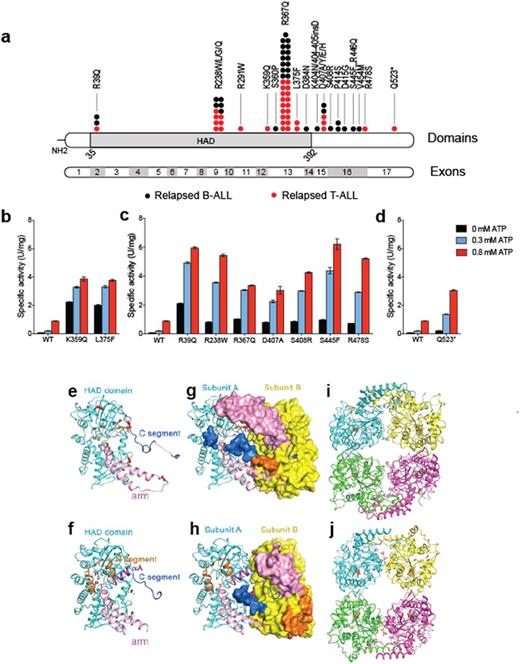Abstract

Relapse acute lymphoblastic leukemia (ALL) is associated with chemotherapy resistance and poor prognosis. Persistent leukemia initiating cells with increased self-renewal capacity, clonal heterogeneity and selection of resistance-driving genetic alterations have been proposed as drivers of leukemia relapse. Gain of function mutations in the 5'-Nucleotidase, Cytosolic II (NT5C2) gene are selectively present in relapsed ALL and confer resistance to chemotherapy with 6-mercaptopurine (6-MP). Yet, the specific mechanisms mediating constitutive activation of NT5C2 remain unknown. Here we performed detailed genetic, enzymatic, structural and functional analyses of relapsed leukemia-associated NT5C2 mutant alleles uncovering previously unrecognized functional heterogeneity in their mechanisms of action. Specifically, detailed nucleotidase assays in the presence of increased concentration of allosteric activators across 10 relapse-associated NT5C2 mutant proteins and analyses of the crystal structures of 7 distinct mutant proteins and wild type NT5C2 in the presence and absence of allosteric factors defined three classes of NT5C2 mutants with distinct mechanisms of action. Class I NT5C2 mutations force an active configuration of the NT5C2 catalytic center in the absence of allosteric activator. In contrast, class II NT5C2 mutations disrupt a novel switch-off mechanism mediated by the dynamic mobilization of the tip region of the arm segment responsible for returning the enzyme to its basal inactive configuration following allosteric activation. Finally, increased allosteric response in the class III p.Gln523* truncating mutation results from loss of the C-terminal acidic tail of NT5C2, which functions as a lock stabilizing the enzyme in its inactive basal configuration. The proposed role of the arm domain region and the C-terminal segment were verified in enzymatic assays incubating wild type NT5C2 with antibodies recognizing these regulatory elements, which phenocopied the increased enzymatic activity and response to allosteric effector of NT5C2 mutations involving these domains. In all, these results identify distinct molecular mechanisms mediating NT5C2 regulation targeted by activating NT5C2 mutant alleles and serve as a framework for the functional annotation of clinically-relevant NT5C2 mutations in relapsed ALL. Finally, the prominent role of the allosteric binding site as critical mediator of the mechanisms mediating thhe increased nucleotidase activity of NT5C2 mutant proteins point to this region as a preferred target for the design of NT5C2 inhibitors for the reversal of chemotherapy resistance in relapsed ALL.
Figure 1 Relapse associated NT5C2 mutations and crystal structure of basal and activated wild type human NT5C2. (a) Graphical representation of relapse associated mutations in B-ALL (black) and T-ALL (red).(b-d) In vitro nucleotidase assays assessing the enzymatic activity of (b)class I, (c) class II, and (d)class IIINT5C2 mutations in the presence of increased concentrations of ATP. (e) A Ribbon diagram of the basal structure of wild type NT5C2-X537, displaying the HAD domain (cyan) and its three extensions: N-terminal segment (orange), arm (pink), and C-terminal segment (marine). The mutation sites are depicted as red solid spheres for Cα of each mutated amino acid. The phosphate (yellow for phosphorus) and Mg ions (dark green) are depicted as stick models and solid spheres respectively. (f) A Ribbon diagram of the activated structure of the full-length wild type NT5C2, in which the allosteric helix A (αA) is shown in dark purple. (g,h) Ribbon and surface (for subunit B) depictions of basal and activated dimers of (g) NT5C2-X537 and the (h) full-length, respectively. (i,j) Ribbon diagrams of the basal (i) NT5C2-X537 and activated (j) full-length wild type tetramers, respectively.
No relevant conflicts of interest to declare.
Author notes
Asterisk with author names denotes non-ASH members.

This icon denotes a clinically relevant abstract


This feature is available to Subscribers Only
Sign In or Create an Account Close Modal